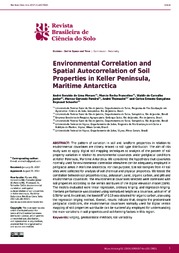Environmental correlation and spatial autocorrelation of soil properties in Keller Peninsula, Maritime Antarctica.
Environmental correlation and spatial autocorrelation of soil properties in Keller Peninsula, Maritime Antarctica.
Autoria: MORAES, A. G. de L.; FRANCELINO, M. R.; CARVALHO JUNIOR, W. de; PEREIRA, M. G.; THOMAZINI, A.; SCHAEFER, C. E. G. R.
Resumo: The pattern of variation in soil and landform properties in relation to environmental covariates are closely related to soil type distribution. The aim of this study was to apply digital soil mapping techniques to analysis of the pattern of soil property variation in relation to environmental covariates under periglacial conditions at Keller Peninsula, Maritime Antarctica. We considered the hypothesis that covariates normally used for environmental correlation elsewhere can be adequately employed in periglacial areas in Maritime Antarctica. For that purpose, 138 soil samples from 47 soil sites were collected for analysis of soil chemical and physical properties. We tested the correlation between soil properties (clay, potassium, sand, organic carbon, and pH) and environmental covariates. The environmental covariates selected were correlated with soil properties according to the terrain attributes of the digital elevation model (DEM). The models evaluated were linear regression, ordinary kriging, and regression kriging. The best performance was obtained using normalized height as a covariate, with an R2 of 0.59 for sand. In contrast, the lowest R2 of 0.15 was obtained for organic carbon, also using the regression kriging method. Overall, results indicate that, despite the predominant periglacial conditions, the environmental covariates normally used for digital terrain mapping of soil properties worldwide can be successfully employed for understanding the main variations in soil properties and soil-forming factors in this region. Keywords: kriging, geostatistical methods, soil variability.
Ano de publicação: 2017
Tipo de publicação: Artigo de periódico
Unidade: Embrapa Solos
Palavras-chave: Krigagem, Métodos geoestatísticos, Variabilidade do solo
Observações
1 - Por padrão são exibidas publicações dos últimos 20 anos. Para encontrar publicações mais antigas, configure o filtro ano de publicação, colocando o ano a partir do qual você deseja encontrar publicações. O filtro está na coluna da esquerda na busca acima.
2 - Para ler algumas publicações da Embrapa (apenas as que estão em formato ePub), é necessário ter, no celular ou computador, um desses softwares gratuitos. Sistemas Android: Google Play Livros; IOS: iBooks; Windows e Linux: software Calibre.
Acesse outras publicações
Acesse a Base de Dados da Pesquisa Agropecuária (BDPA) para consultar o acervo completo das bibliotecas da Embrapa.

